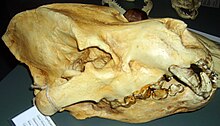| Percrocutidae Temporal range: Middle Miocene to Late Pliocene | |
|---|---|
 | |
| Dinocrocuta gigantea skull cast, Zoological Museum in Copenhagen | |
| Scientific classification | |
| Domain: | Eukaryota |
| Kingdom: | Animalia |
| Phylum: | Chordata |
| Class: | Mammalia |
| Order: | Carnivora |
| Suborder: | Feliformia |
| Superfamily: | Herpestoidea |
| Family: | † Percrocutidae Werdelin & Solounias, 1991 |
| Genera | |
Percrocutidae is an extinct family of hyena-like feliform carnivorans endemic to Asia, Africa, and Southern Europe from the Middle Miocene through the Pliocene, existing for about 8 million years. [1]
Contents
The first percrocutids are known from the middle Miocene of Europe and western Asia and belonged to the genus Percrocuta . Percrocuta already had large premolars, but did not carry such a massive bite as the later form Dinocrocuta , from the later Miocene. [2] Originally, these carnivores were placed with the hyenas in the family Hyaenidae. As of 2022 [update] , most scientists considered the Percrocutidae to be a distinct family that evolved their morphology similar to hyenas due convergent evolution, [3] - although they are usually placed sister-taxa/immediate outgroup to Hyaenidae. [4] Sometimes it was placed with the family Stenoplesictidae into the superfamily Stenoplesictoidea. A 2022 study placed Dinocrocuta and Percrocuta as true hyaenids, which if correct would invalidate the family Percrocutidae. [3]
